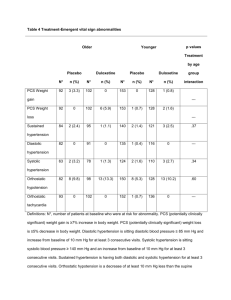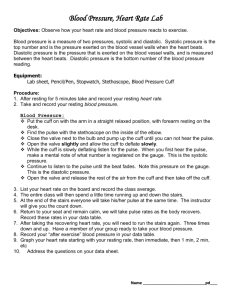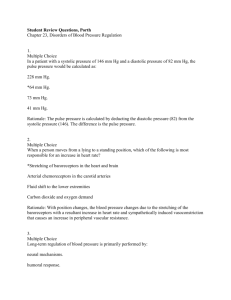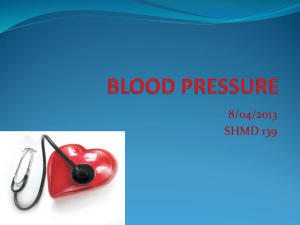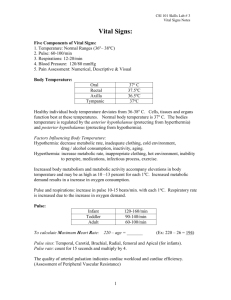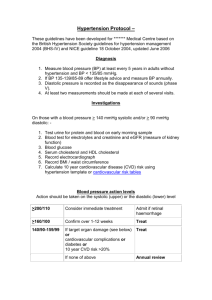Understanding Blood Pressure and Heart Rate What is BP
advertisement
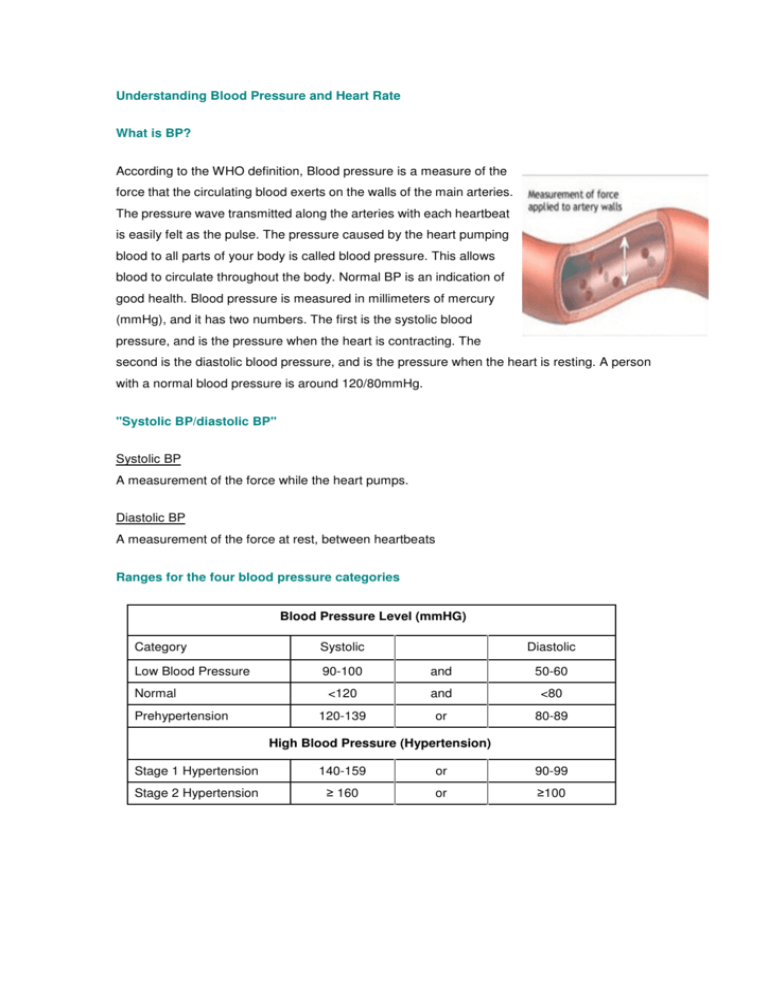
Understanding Blood Pressure and Heart Rate What is BP? According to the WHO definition, Blood pressure is a measure of the force that the circulating blood exerts on the walls of the main arteries. The pressure wave transmitted along the arteries with each heartbeat is easily felt as the pulse. The pressure caused by the heart pumping blood to all parts of your body is called blood pressure. This allows blood to circulate throughout the body. Normal BP is an indication of good health. Blood pressure is measured in millimeters of mercury (mmHg), and it has two numbers. The first is the systolic blood pressure, and is the pressure when the heart is contracting. The second is the diastolic blood pressure, and is the pressure when the heart is resting. A person with a normal blood pressure is around 120/80mmHg. "Systolic BP/diastolic BP" Systolic BP A measurement of the force while the heart pumps. Diastolic BP A measurement of the force at rest, between heartbeats Ranges for the four blood pressure categories Blood Pressure Level (mmHG) Category Systolic Low Blood Pressure 90-100 and 50-60 <120 and <80 120-139 or 80-89 Normal Prehypertension Diastolic High Blood Pressure (Hypertension) Stage 1 Hypertension 140-159 or 90-99 Stage 2 Hypertension ≥ 160 or ≥100 140/90 What is High Blood Pressure? (Hypertension) A person has hypertension when his blood pressure remains persistently higher than it should normally be. It occurs when pressure builds up in the arteries as the heart pumps the blood round. Hypertension is defined as systolic blood pressure ≥140 mmHg or diastolic blood pressure ≥90 mmHg. Hypertension damages smooth artery walls, creating anchor points for plaque latch on to. It is a silent killer which does not have any symptoms but it can cause heart disease and stroke. However, blood pressure, like height and weight, is a continuous biological variable and varies by your emotions, the weather with no cut-off point separating normotension from hypertension. It is estimated that there are over 6 hundred millions people with hypertension and it is currently affects 26% of the adult population who aged over 15. Why is High Blood Pressure Dangerous? High blood pressure makes the heart work harder than it should, causing it to get weaker over time. The higher your blood pressure, the greater your risk of heart attack and stroke. 30% of hypertensive patient may occurred ventricular hypertrophy and in the long-term it may increase total risk of stroke by 4 times. Therefore, 10–15 mmHg lower for systolic blood pressure and 5–10 mmHg lower for diastolic blood pressure are the goal values. Treating systolic and diastolic blood pressure to target is associated with a decrease in cardiovascular complications. This includes 35%–40% mean reduction in stroke incidence, 20%–25% mean reduction in myocardial infarction and >50% mean reduction in heart failure. How Can I Prevent High Blood Pressure? You can prevent high blood pressure by: - Maintaining a healthy weight. Lose weight if you are overweight. - Exercising more. - Eating foods low in salt. - Drinking alcoholic beverages in moderation, if you drink at all. Blood Pressure Measurement Hypertension can only be diagnosed by measurement of blood pressure. Before measurement commences the patient should be seated for several minutes in a quiet room. The arm muscles should be relaxed and the forearm supported such that the cubital fossa is at heart level (fourth intercostal space). If the blood pressure is greater than 140/90, it should be repeated and both values should be recorded. Both systolic and diastolic blood pressure should be measured at least twice over a period of no less than three minutes; all the readings should be recorded and the mean value for both systolic and diastolic blood pressure should be used. Tips High blood pressure had no symptoms, but can cause a sudden stroke or heart attack. Have your blood pressure checked regularly. What Is Low Blood Pressure? Hypotension is the medical term for low blood pressure (less than 90/60). Normal blood pressure is usually in the range of 120/80 (systolic/diastolic). People who have lower blood pressures have a lower risk of strokes, kidney disease, and heart diseases. Athletes, people who exercise regularly, people who maintain ideal body weights, and non-smokers, tend to have lower blood pressures. Therefore, low blood pressure is desirable as long as it is not low enough to cause symptoms and damage to organs in the body. But low blood pressure can be a signal of an underlying problem — especially in the elderly. In this population, low blood pressure may cause inadequate blood flow to the heart, brain and other vital organs Chronic low blood pressure is almost never serious. But health problems occur when blood pressure drops suddenly and the brain is deprived of an adequate blood supply. This can lead to dizziness or lightheadedness and a sudden drop in blood pressure that causes a sudden, brief loss of consciousness that t most commonly occurs in someone who's rising from a prone or sitting position to a standing position. Physiological Changes During Exercise- Heart When resting, the adult human heart beats at about 70 bpm (males) and 75 bpm (females), but this rate varies among people. The heart rate increases when we are active or when we feel strong emotions. The heart is first and foremost a pump. It pumps oxygenated blood to the body to support the production of cellular energy. During exercise, working muscles increase their cellular energy requirements up to 100X. Generating more energy (ATP) requires more oxygen delivery to the mitochondria. Therefore heart rate will increase (from 70bpmà200bpm ) to sustain work at a greater maximal intensity. How to Measure Heart Rate and Target Heart Rate Zone? A heart rate monitor is a tool that will help to pace you and monitoring your exercise heart rate. Besides, the pulse rate can be measured at any point on the body where an artery is close to the surface. Such places are wrist and neck and you can count your own heartbeat for a minute. Resting Heart Rate The most accurate resting heart rate per minute can be obtained by taking the radial pulse once you wake up in early morning. Male Resting HR(pulse) (per minute) Female Age 20 – 29 30 – 39 20 – 29 30 – 39 Excellent <58 <58 <64 <62 Good 59 – 63 59 – 63 65 – 66 63 – 65 Fair 64 – 70 64 -72 67 – 78 66 – 75 Normal 71 – 81 73 – 81 79 – 82 76 – 81 A bit high >82 >82 >83 >82 Taking Your Heart Rate Generally, to determine whether you are exercising within the heart rate target zone, you must stop exercising briefly to take your pulse. You can take the pulse at the neck, the wrist, or the chest. We recommend the wrist. You can feel the radial pulse on the artery of the wrist in line with the thumb. Place the tips of the index and middle fingers over the artery and press lightly. Do not use the thumb. Take a full 60-second count of the heartbeats, or take for 30 seconds and multiply by 2. Start the count on a beat, which is counted as "zero." If this number falls between 85 and 119 bpm in the case of the 50-year-old person, he or she is active within the target range for moderate-intensity activity. Why We Have to Take Our Target Heart Rate During Exercise? Once we have chosen our desired exercise, we also have to decide the vigorous level of it. There is an element called "intensity" which is expressed as a percentage. Target heart rate (THR), is a desired range of heart rate reached during aerobic exercise which enables one's heart and lungs to receive the most benefit from a workout. THR can be calculated by using a range of 50%–85% intensity. By using this figure, you can ensure that you're working out at the right intensity to achieve your exercise goal. HR Reserved or Karvonen Formula 1. The Karvonen formula factors in Resting Heart Rate (HRrest) to calculate Target Heart Rate (THR): 2. Its unit is the same with the VO2max HR reserve = Maximal HR - Resting HR ( HRR ) = ( 220 - AGE ) - HRrest Target Heart Rate After that, to find your zone, take this HRR and multiply it by 0.50 and 0.85 to get the 50% and 85% range. And then adding your resting heart rate, as follow: Target Heart Rate=Heart Rate Reserve (50%~85%) + Resting Heart Rate 50%: low end of heart rate 85%: high end of heart rate Example A 40-year-old lady with 80bpm resting heart rate who wants to participate in moderate-intensity physical activity, how to determine her target heart rate? THR = (HRmax – HRrest X %Intensity) + HRrest Step one: Heart Rate Reserve = 220 – 40- 80 = 100 bpm Step two: low end of heart rate = 100 x 50% + 80 = 50 + 80 = 130 bpm Step three: high end of heart rate = 100 x 85% + 70 = 85 + 70 = 155 bpm Thus, moderate-intensity physical activity for a 40-year-old person will require that the heart rate remains between 130 and 155 bpm during physical activity. If she is a beginner, try to start with 50% intensity then increase it progressively. If she is endomorphic or used to be in sedentary life style, try to start with 40% of HRR (120 bpm). Reference Avoiding hearts attack and strokes, don’t be a victim- protect yourself. WHO. http://www.who.int/cardiovascular_diseases/resources/avoid_heart_attack_report.pdf High blood pressure, Carlene M.M.L el, WHO http://www.who.int/publications/cra/chapters/volume1/0281-0390.pdf WHO, htp://www.emro.who.int/publications/EMRO%20PUB-TPS-hyper-DIA-BPM.HTM Low Blood Pressure (Hypotension), Dennis Lee, http://www.medicinenet.com/low_blood_pressure/article.htm 運動後心臟的恢復 體育教學資源 http://hk.geocities.com/physicalfitnesshk/new_page_7.htm http://www.pe-web.org/theory/theory.php?index=4 沈 劍 威 、 阮 伯 仁 ( 2006) ︰ 《 體 適 能 基 礎 理 論 》 。 香 港 : 香 港 體 適 能 總 會 。 低血壓 中醫從補腎著手 http://www.libertytimes.com.tw/2001/new/mar/5/today-m1.htm


